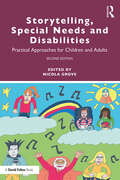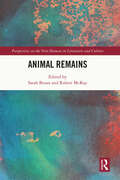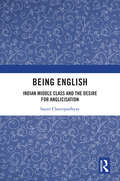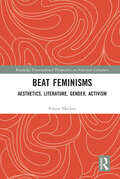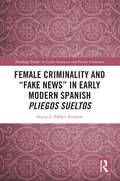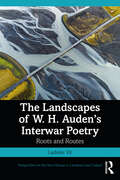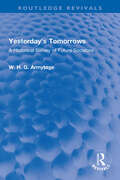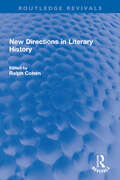- Table View
- List View
Storytelling, Special Needs and Disabilities: Practical Approaches for Children and Adults
by Nicola GroveNow in a fully revised and updated second edition, this innovative and wide-ranging book shows how storytelling can open new worlds for individuals with special educational needs and disabilities. Providing a highly accessible combination of theory and practice, the contributors to this book define their own approaches to inclusive storytelling, describing the principles and theory that underpin their practice, whilst never losing sight of the joy at the heart of their work. Topics include therapeutic storytelling; language and communication; interactive and multi-sensory storytelling; and technology. Each chapter includes top tips, and signposts further training for practitioners who want to start using stories in their own work, making this book a crucial and comprehensive guide to storytelling practice with diverse learners. This new edition: · has been fully updated to reflect the way in which this field of storytelling has grown and developed · uses a broad range of chapters, structured in a way that guides the reader through the conceptualisation of a storytelling approach towards its practical application · includes an additional chapter, sharing the lived experiences of storytellers who identify as having a disability. Full of inspiring ideas to be used with people of all ages and with a range of needs, this book will be an invaluable tool for education professionals, as well as therapists, youth workers, counsellors and theatre practitioners working in special education.
Storytelling, Special Needs and Disabilities: Practical Approaches for Children and Adults
by Nicola GroveNow in a fully revised and updated second edition, this innovative and wide-ranging book shows how storytelling can open new worlds for individuals with special educational needs and disabilities. Providing a highly accessible combination of theory and practice, the contributors to this book define their own approaches to inclusive storytelling, describing the principles and theory that underpin their practice, whilst never losing sight of the joy at the heart of their work. Topics include therapeutic storytelling; language and communication; interactive and multi-sensory storytelling; and technology. Each chapter includes top tips, and signposts further training for practitioners who want to start using stories in their own work, making this book a crucial and comprehensive guide to storytelling practice with diverse learners. This new edition: · has been fully updated to reflect the way in which this field of storytelling has grown and developed · uses a broad range of chapters, structured in a way that guides the reader through the conceptualisation of a storytelling approach towards its practical application · includes an additional chapter, sharing the lived experiences of storytellers who identify as having a disability. Full of inspiring ideas to be used with people of all ages and with a range of needs, this book will be an invaluable tool for education professionals, as well as therapists, youth workers, counsellors and theatre practitioners working in special education.
Animal Remains (Perspectives on the Non-Human in Literature and Culture)
by Sarah Bezan Robert McKayThe dream of humanism is to cleanly discard of humanity’s animal remains along with its ecological embeddings, evolutionary heritages and futures, ontogenies and phylogenies, sexualities and sensualities, vulnerabilities and mortalities. But, as the contributors to this volume demonstrate, animal remains are everywhere and so animals remain everywhere. Animal remains are food, medicine, and clothing; extractive resources and traces of animals’ lifeworlds and ecologies; they are sites of political conflict and ontological fear, fetishized visual signs and objects of trade, veneration and memory; they are biotechnological innovations, and spill-over viruses. To make sense of the material afterlives of animals, this book draws together multispecies perspectives from literary criticism and theory, cultural studies, anthropology and ethnography, photographic and film history, and contemporary art practice to offer the first synoptic account of animal remains. Interpreting them in all their ubiquity, diversity and persistence, Animal Remains reveals posthuman relations between human and nonhuman communities of the living and the dead, on timescales of decades, centuries, and millennia.
Animal Remains (Perspectives on the Non-Human in Literature and Culture)
by Sarah Bezan Robert McKayThe dream of humanism is to cleanly discard of humanity’s animal remains along with its ecological embeddings, evolutionary heritages and futures, ontogenies and phylogenies, sexualities and sensualities, vulnerabilities and mortalities. But, as the contributors to this volume demonstrate, animal remains are everywhere and so animals remain everywhere. Animal remains are food, medicine, and clothing; extractive resources and traces of animals’ lifeworlds and ecologies; they are sites of political conflict and ontological fear, fetishized visual signs and objects of trade, veneration and memory; they are biotechnological innovations, and spill-over viruses. To make sense of the material afterlives of animals, this book draws together multispecies perspectives from literary criticism and theory, cultural studies, anthropology and ethnography, photographic and film history, and contemporary art practice to offer the first synoptic account of animal remains. Interpreting them in all their ubiquity, diversity and persistence, Animal Remains reveals posthuman relations between human and nonhuman communities of the living and the dead, on timescales of decades, centuries, and millennia.
Great Indian Epics: International Perspectives
by Udayanath Sahoo Shobha Rani DashThis volume brings together a number of seminal studies presented at the International Conference on Great Indian Epics held in February 2019 at the Jawaharlal Nehru University, New Delhi by scholars from various parts of the world. Each article adds a new dimension to the subject with historical scholarship and critical interpretation, reflecting comprehensiveness, unity, clarity and rightness of perception. This definitive work adds to our knowledge of the epics and their infinite influence.Please note: Taylor & Francis does not sell or distribute the Hardback in India, Pakistan, Nepal, Bhutan, Bangladesh and Sri Lanka.
Great Indian Epics: International Perspectives
by Udayanath Sahoo Shobha Rani DashThis volume brings together a number of seminal studies presented at the International Conference on Great Indian Epics held in February 2019 at the Jawaharlal Nehru University, New Delhi by scholars from various parts of the world. Each article adds a new dimension to the subject with historical scholarship and critical interpretation, reflecting comprehensiveness, unity, clarity and rightness of perception. This definitive work adds to our knowledge of the epics and their infinite influence.Please note: Taylor & Francis does not sell or distribute the Hardback in India, Pakistan, Nepal, Bhutan, Bangladesh and Sri Lanka.
Being English: Indian Middle Class and the Desire for Anglicisation
by Sayan ChattopadhyayThis book critically examines the cultural desire for anglicisation of the Indian middle class in the context of postcolonial India. It looks at the history of anglicised self-fashioning as one of the major responses of the Indian middle class to British colonialism. The book explores the rich variety of nineteenth- and twentieth-century writings that document the attempts by the Indian middle class to innovatively interpret their personal histories, their putative racial histories, and the history of India to appropriate the English language and lay claim to an “English” identity. It discusses this unique quest for “Englishness” by reading the works of authors like Michael Madhusudan Dutt, Rabindranath Tagore, Cornelia Sorabji, Nirad C. Chaudhuri, Dom Moraes, and Salman Rushdie. An important intervention, this book will be of interest to scholars and researchers of postcolonial studies, Indian English literature, South Asian studies, cultural studies, and English literature in general.
Being English: Indian Middle Class and the Desire for Anglicisation
by Sayan ChattopadhyayThis book critically examines the cultural desire for anglicisation of the Indian middle class in the context of postcolonial India. It looks at the history of anglicised self-fashioning as one of the major responses of the Indian middle class to British colonialism. The book explores the rich variety of nineteenth- and twentieth-century writings that document the attempts by the Indian middle class to innovatively interpret their personal histories, their putative racial histories, and the history of India to appropriate the English language and lay claim to an “English” identity. It discusses this unique quest for “Englishness” by reading the works of authors like Michael Madhusudan Dutt, Rabindranath Tagore, Cornelia Sorabji, Nirad C. Chaudhuri, Dom Moraes, and Salman Rushdie. An important intervention, this book will be of interest to scholars and researchers of postcolonial studies, Indian English literature, South Asian studies, cultural studies, and English literature in general.
Holocaust and the Stars: The Past in the Prose of Stanisław Lem (Studies in Global Genre Fiction)
by Agnieszka GajewskaThis book is a groundbreaking study of one of the greatest science fiction writers, the Polish master Stanisław Lem. It offers a new direction in research on his oeuvre and corrects several errors commonly appearing in his biographies. The author painstakingly recreates the context of Lem’s early life and his traumatic experiences during the Second World War due to his Jewish background, and then traces these through original and brilliant readings of his fiction and non-fiction. She considers language, worldbuilding, themes, motifs and characterization as well as many buried allusions to the Holocaust in Lem’s published and archival work, and uses these fragments to capture a different side of Lem than previously known. The book discusses various issues concerning the writer’s life, such as his upbringing in a Jewish, Zionist-minded family, the extensive relations between the Lem family and the elite of Lviv at that time, details of the Lem family killed during the German occupation and attempts to reconstruct what happened to Lem’s parents and to the writer himself after escaping the ghetto. Part of the Studies in Global Genre Fiction series, this English translation of the Polish original, which has already been considered a milestone in Lem studies, offers a fresh perspective on the writer and his work. It will be an important intervention for scholars and researchers of Jewish studies, Holocaust literature, science fiction studies, English literature, world war studies, minority studies, popular culture, history and cultural studies.
Holocaust and the Stars: The Past in the Prose of Stanisław Lem (Studies in Global Genre Fiction)
by Agnieszka GajewskaThis book is a groundbreaking study of one of the greatest science fiction writers, the Polish master Stanisław Lem. It offers a new direction in research on his oeuvre and corrects several errors commonly appearing in his biographies. The author painstakingly recreates the context of Lem’s early life and his traumatic experiences during the Second World War due to his Jewish background, and then traces these through original and brilliant readings of his fiction and non-fiction. She considers language, worldbuilding, themes, motifs and characterization as well as many buried allusions to the Holocaust in Lem’s published and archival work, and uses these fragments to capture a different side of Lem than previously known. The book discusses various issues concerning the writer’s life, such as his upbringing in a Jewish, Zionist-minded family, the extensive relations between the Lem family and the elite of Lviv at that time, details of the Lem family killed during the German occupation and attempts to reconstruct what happened to Lem’s parents and to the writer himself after escaping the ghetto. Part of the Studies in Global Genre Fiction series, this English translation of the Polish original, which has already been considered a milestone in Lem studies, offers a fresh perspective on the writer and his work. It will be an important intervention for scholars and researchers of Jewish studies, Holocaust literature, science fiction studies, English literature, world war studies, minority studies, popular culture, history and cultural studies.
Katherine Mansfield: International Approaches (Routledge Studies in Twentieth-Century Literature)
by Janka Kascakova Gerri Kimber W 322 Adys 322 Aw WitaliszKatherine Mansfield has been widely recognised as one of the key authors of her generation, continuing to influence literary modernism and the short story genre through her nomadic existence, colonial perspective, eclectic interests and impressive range of literary acquaintances. This volume utilises these seemingly endless avenues for critical exploration, analysing Mansfield’s influences, including the familial, historical and geographical as well as literary and artistic approaches. Some connections are well established and acknowledged, some controversial, many still undiscovered. This volume brings a fresh collection of original viewpoints on Katherine Mansfield’s life and work, both of which, in her own case, are frequently indistinguishable. It investigates her fascinating connection with Poland which is explored in a complex and detailed way for the first time; suggests new or revised views on her connections to other English and American writers; and finally examines some of the aspects of her writing process, her engagement with the arts, imagination, memories and her constructions of different kinds of space.
Katherine Mansfield: International Approaches (Routledge Studies in Twentieth-Century Literature)
by Janka Kascakova, Gerri Kimber and Władysław WitaliszKatherine Mansfield has been widely recognised as one of the key authors of her generation, continuing to influence literary modernism and the short story genre through her nomadic existence, colonial perspective, eclectic interests and impressive range of literary acquaintances. This volume utilises these seemingly endless avenues for critical exploration, analysing Mansfield’s influences, including the familial, historical and geographical as well as literary and artistic approaches. Some connections are well established and acknowledged, some controversial, many still undiscovered. This volume brings a fresh collection of original viewpoints on Katherine Mansfield’s life and work, both of which, in her own case, are frequently indistinguishable. It investigates her fascinating connection with Poland which is explored in a complex and detailed way for the first time; suggests new or revised views on her connections to other English and American writers; and finally examines some of the aspects of her writing process, her engagement with the arts, imagination, memories and her constructions of different kinds of space.
Beat Feminisms: Aesthetics, Literature, Gender, Activism (Routledge Transnational Perspectives on American Literature)
by Polina MackayThis is the first book-length study to read women of the Beat Generation as feminist writers. The book focuses on one author from each of the three generations that comprise the groups of female writers associated with the Beats – Diane di Prima, ruth weiss and Anne Waldman – as well as on experimental and multimedia artists, such as Laurie Anderson and Kathy Acker, who have not been read through the prism of Beat feminism before. Beat Feminisms argues that these writers’ feminism evolved over time, but retained a focus on intertextuality, on visions of transformation, on revisions of patriarchal discourses, on gender and on interventionist poetics within the context of activism. The book shows how these Beat feminisms counteract the ways in which women have been undermined, possessed or silenced.
Beat Feminisms: Aesthetics, Literature, Gender, Activism (Routledge Transnational Perspectives on American Literature)
by Polina MackayThis is the first book-length study to read women of the Beat Generation as feminist writers. The book focuses on one author from each of the three generations that comprise the groups of female writers associated with the Beats – Diane di Prima, ruth weiss and Anne Waldman – as well as on experimental and multimedia artists, such as Laurie Anderson and Kathy Acker, who have not been read through the prism of Beat feminism before. Beat Feminisms argues that these writers’ feminism evolved over time, but retained a focus on intertextuality, on visions of transformation, on revisions of patriarchal discourses, on gender and on interventionist poetics within the context of activism. The book shows how these Beat feminisms counteract the ways in which women have been undermined, possessed or silenced.
Female Criminality and “Fake News” in Early Modern Spanish Pliegos Sueltos (Routledge Studies in Latin American and Iberian Literature)
by Stacey L. Parker AronsonThis book studies the Early Modern Spanish broadsheet, the tabloid newspaper of its day which functioned to educate, entertain, and indoctrinate its readers, much like today’s "fake news." Parker Aronson incorporates a socio-historical approach in which she considers crime and deviance committed by women in Early Modern Spain and the correlation between crime and the growth of urban centers. She also considers female deviance more broadly to encompass sexual and religious deviance while investigating the relationship between these pliegos sueltos and the transgressive and disruptive nature of female criminality. In addition to an introduction to this fascinating subgenre of Early Modern Spanish literature, Parker Aronson analyzes the representations of women as bandits and highway robbers; as murderers; as prostitutes, libertines, and actors; as Christian renegades; as enlaved people; as witches; as miscegenationists; and as the recipients of punishment.
Female Criminality and “Fake News” in Early Modern Spanish Pliegos Sueltos (Routledge Studies in Latin American and Iberian Literature)
by Stacey L. Parker AronsonThis book studies the Early Modern Spanish broadsheet, the tabloid newspaper of its day which functioned to educate, entertain, and indoctrinate its readers, much like today’s "fake news." Parker Aronson incorporates a socio-historical approach in which she considers crime and deviance committed by women in Early Modern Spain and the correlation between crime and the growth of urban centers. She also considers female deviance more broadly to encompass sexual and religious deviance while investigating the relationship between these pliegos sueltos and the transgressive and disruptive nature of female criminality. In addition to an introduction to this fascinating subgenre of Early Modern Spanish literature, Parker Aronson analyzes the representations of women as bandits and highway robbers; as murderers; as prostitutes, libertines, and actors; as Christian renegades; as enlaved people; as witches; as miscegenationists; and as the recipients of punishment.
The Landscapes of W. H. Auden’s Interwar Poetry: Roots and Routes (Perspectives on the Non-Human in Literature and Culture)
by Ladislav VítThis is the first book-length study foregrounding Auden’s sense of place as a means for enhancing our grasp of this crucial twentieth-century poet. Proposing that Auden had a remarkable spatial sensibility, this book concentrates on his treatment of his homeland England, as well as the North Pennines and Iceland, both of which served as his ‘good’ places, ‘holy’ grounds and sources of topophilic sentiment. The readings draw on the scholarship of humanistic geography, tracing patterns of mental constructs which emerge from spatial experience. In a scholarly but engaging way, this book argues that focusing on Auden’s poetics of place as it emerged and evolved can be instrumental to our understanding of this influential poet not only in relation to his epoch but also to the Anglophone poetic tradition. Precisely because of his stature, these elaborations on Auden’s preoccupation with places, escapism, borders and local identity promise to enrich our understanding of the cultural and intellectual climate of the interwar period, when established notions of local places and cultures were beginning to be contested by internationalisation. This study will be of interest to both academics and students in the field of Anglophone literary studies while also appealing to those attracted to Auden’s poetry, interwar culture and the literary representation of space.
The Landscapes of W. H. Auden’s Interwar Poetry: Roots and Routes (Perspectives on the Non-Human in Literature and Culture)
by Ladislav VítThis is the first book-length study foregrounding Auden’s sense of place as a means for enhancing our grasp of this crucial twentieth-century poet. Proposing that Auden had a remarkable spatial sensibility, this book concentrates on his treatment of his homeland England, as well as the North Pennines and Iceland, both of which served as his ‘good’ places, ‘holy’ grounds and sources of topophilic sentiment. The readings draw on the scholarship of humanistic geography, tracing patterns of mental constructs which emerge from spatial experience. In a scholarly but engaging way, this book argues that focusing on Auden’s poetics of place as it emerged and evolved can be instrumental to our understanding of this influential poet not only in relation to his epoch but also to the Anglophone poetic tradition. Precisely because of his stature, these elaborations on Auden’s preoccupation with places, escapism, borders and local identity promise to enrich our understanding of the cultural and intellectual climate of the interwar period, when established notions of local places and cultures were beginning to be contested by internationalisation. This study will be of interest to both academics and students in the field of Anglophone literary studies while also appealing to those attracted to Auden’s poetry, interwar culture and the literary representation of space.
Joginder Paul: The Writerly Writer (Writer in Context)
by Chandana DuttaThis book is a comprehensive volume on the life and works of Joginder Paul, a well-known Urdu fiction writer and thinker. It presents a selection from the writer’s oeuvre – a few of his short stories, extracts from his long fiction, samples of his micro-fiction, personal reminiscences, and some of his incisive critical essays written in Urdu as well as in English that lay out his ideas on the role of the writer and the art of writing. The volume also contextualises his work within the Urdu literary tradition and beyond through some critical essays on him from across time and geography. It situates Paul as a notable fiction writer and an essayist who broke convention in his writing and crafted his own individual style. It shows how he was received in Urdu while also placing him as an important creative voice within a larger pan-Indian literary context. The book also focuses on Paul’s efforts to effect a change in how fiction should be perceived, particularly by his readers who he considered the most important ally-participant in his effort to create stories. This volume will help to evolve a deeper understanding of the thematic subtleties in his fiction, as well as the critical perspectives he offers in his non-fiction. Part of the Writer in Context series, this book will be indispensable to scholars and researchers in literature, history, sociology, language and creative writing, Partition studies, translation studies, Indian writings, Urdu literature, postcolonial studies, and South Asian Studies.
Joginder Paul: The Writerly Writer (Writer in Context)
by Chandana DuttaThis book is a comprehensive volume on the life and works of Joginder Paul, a well-known Urdu fiction writer and thinker. It presents a selection from the writer’s oeuvre – a few of his short stories, extracts from his long fiction, samples of his micro-fiction, personal reminiscences, and some of his incisive critical essays written in Urdu as well as in English that lay out his ideas on the role of the writer and the art of writing. The volume also contextualises his work within the Urdu literary tradition and beyond through some critical essays on him from across time and geography. It situates Paul as a notable fiction writer and an essayist who broke convention in his writing and crafted his own individual style. It shows how he was received in Urdu while also placing him as an important creative voice within a larger pan-Indian literary context. The book also focuses on Paul’s efforts to effect a change in how fiction should be perceived, particularly by his readers who he considered the most important ally-participant in his effort to create stories. This volume will help to evolve a deeper understanding of the thematic subtleties in his fiction, as well as the critical perspectives he offers in his non-fiction. Part of the Writer in Context series, this book will be indispensable to scholars and researchers in literature, history, sociology, language and creative writing, Partition studies, translation studies, Indian writings, Urdu literature, postcolonial studies, and South Asian Studies.
Katha Vilasam: The Story Within
by S RamakrishnanKatha Vilasam: The Story Within offers a path-breaking series of 50 articles by S. Ramakrishnan, published over the course of four years in the widely read Tamil magazine Ananda Vikatan, to a wider reading public through translation into English. The writing style is intentionally direct and compact to suit a magazine readership. Nevertheless, the prose is elevating, even lyrical at times. There are “Aha” moments aplenty. The author uses a unique device in these units. They are “stories within stories”. In each unit, he describes an incident from his own experience and relates it to a short story he has read by a particular eminent Tamil writer. He paraphrases/summarises the writer’s story, melds it into his own reminiscence, and allows the two to resonate and create a musical signature in the reader’s mind. Thus, 50 noted short story writers in the Tamil language are featured here. The avowed purpose of the author was to introduce the readers of Ananda Vikatan (who may have been readers of nothing but magazines) to also delve into the works of excellent Tamil short story writers. The series ran for four years and was very well received by readers. Each unit deserves to be read and re-read not only for the insights and information about writers in different genres, but for the word wizardry and imagery that flow effortlessly through the lines. It is hoped that this English translation will teleport these unique offerings to a wider reading public and bring the works of excellent Tamil writers into the lives of discriminating lovers of literature everywhere.
Katha Vilasam: The Story Within
by S RamakrishnanKatha Vilasam: The Story Within offers a path-breaking series of 50 articles by S. Ramakrishnan, published over the course of four years in the widely read Tamil magazine Ananda Vikatan, to a wider reading public through translation into English. The writing style is intentionally direct and compact to suit a magazine readership. Nevertheless, the prose is elevating, even lyrical at times. There are “Aha” moments aplenty. The author uses a unique device in these units. They are “stories within stories”. In each unit, he describes an incident from his own experience and relates it to a short story he has read by a particular eminent Tamil writer. He paraphrases/summarises the writer’s story, melds it into his own reminiscence, and allows the two to resonate and create a musical signature in the reader’s mind. Thus, 50 noted short story writers in the Tamil language are featured here. The avowed purpose of the author was to introduce the readers of Ananda Vikatan (who may have been readers of nothing but magazines) to also delve into the works of excellent Tamil short story writers. The series ran for four years and was very well received by readers. Each unit deserves to be read and re-read not only for the insights and information about writers in different genres, but for the word wizardry and imagery that flow effortlessly through the lines. It is hoped that this English translation will teleport these unique offerings to a wider reading public and bring the works of excellent Tamil writers into the lives of discriminating lovers of literature everywhere.
Yesterday's Tomorrows: A Historical Survey of Future Societies (Routledge Revivals)
by W. H. ArmytageFirst published in 1968, Yesterday’s Tomorrows elucidates on the favourite occupation of man: forecasting the future. By man’s predictions, he mirrors his own wish-fulfilments, displacements, projections, denials, evasions and withdrawals. These predications can take the form of countries of the imagination, ‘mirror worlds’ like Rabelais’ Ever-Ever lands or the Erewhon of Butler. Alternatively, they may spring from panic, reflecting fear rather than hope, often manifesting themselves, in our technological age, as reports of ‘flying saucers’ or invasions from another planet. In either form, they provide philosophers, scientists, doctors and sociologists with material for evaluating man’s future needs, offering both criticism of our present society, plans for our future, and release from tension and disequilibrium. Professor Armytage shows in this book how such ‘visions’ can, and do, refresh minds for renewed grappling with the present by arming them with ideas for man’s future needs. He indicates that, out of an apparent welter of futuristic fantasies, a constructive debate about tomorrow is emerging, providing us with operational models of what tomorrow could be. This book will hold special interest for students of philosophy and of English literature.
Yesterday's Tomorrows: A Historical Survey of Future Societies (Routledge Revivals)
by W. H. ArmytageFirst published in 1968, Yesterday’s Tomorrows elucidates on the favourite occupation of man: forecasting the future. By man’s predictions, he mirrors his own wish-fulfilments, displacements, projections, denials, evasions and withdrawals. These predications can take the form of countries of the imagination, ‘mirror worlds’ like Rabelais’ Ever-Ever lands or the Erewhon of Butler. Alternatively, they may spring from panic, reflecting fear rather than hope, often manifesting themselves, in our technological age, as reports of ‘flying saucers’ or invasions from another planet. In either form, they provide philosophers, scientists, doctors and sociologists with material for evaluating man’s future needs, offering both criticism of our present society, plans for our future, and release from tension and disequilibrium. Professor Armytage shows in this book how such ‘visions’ can, and do, refresh minds for renewed grappling with the present by arming them with ideas for man’s future needs. He indicates that, out of an apparent welter of futuristic fantasies, a constructive debate about tomorrow is emerging, providing us with operational models of what tomorrow could be. This book will hold special interest for students of philosophy and of English literature.
New Directions in Literary History (Routledge Revivals)
by Ralph CohenFirst published in 1974, New Directions in Literary History is a comprehensive attempt to present approaches to literary studies that have developed from phenomenology, stylistics and linguistics, Marxist reconsiderations of literature, interdisciplinary studies and analysis of reader response. Written by an international group of scholars, the essays are taken from the pages of New Literary History. They range from the Middle Ages to contemporary literature. European and American literary critics are here represented, together with an art critic, a philosopher and a novelist. Their essays deal with crucial problems in the study of literature: the relationship of the contemporary critic to works of the past; the place of method in literary study; how reading takes place; the role of the reader in different literary periods in providing a guide to interpretation; the language of literature and its relation to natural or ordinary language; the origin and decline of literary forms; and what constitutes literature, especially in the relation between fictional character and autobiography. Although the essays are essentially concerned with theoretical issues, they also examine the practical applications to literature. Students of English literature and literary theory will find this book particularly interesting.
